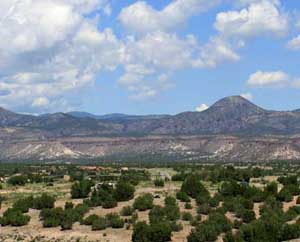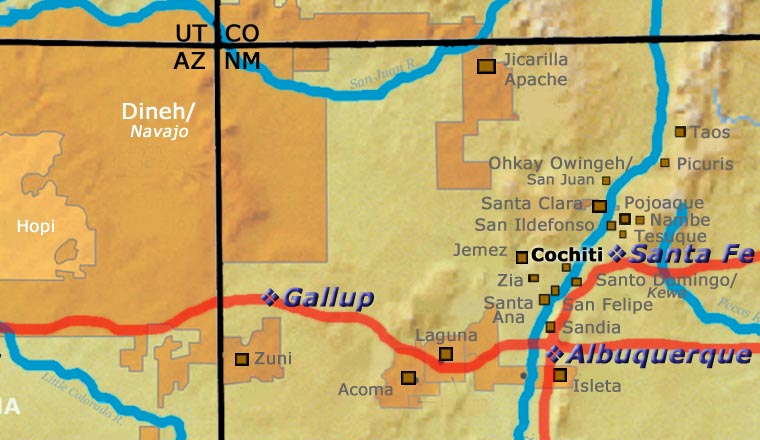
Snowflake Flower
1931-2018
Cochiti

The daughter of Eluterio and Berina Cordero, Estephanita Snowflake Flower Cordero was born into Cochiti Pueblo in December 1931. Her grandmother was Estephanita Herrera. Mary Martin was her cousin, Ada Suina her sister. She grew up watching her mother and grandmother making pottery but she never put her hands in clay herself until her kids were grown and out of the house. Then she went to the University of New Mexico and enrolled in a bilingual education program. She studied Native American art forms, excelled in painting and made her first storyteller figure. She didn't like it: she'd used commercial materials and a kiln to fire it. It just didn't feel right. So she finished her BS in Education at UNM, then went back home and learned how to make pottery the traditional way.
After that, she made storytellers, nativities, jars, bowls and owls. Her favorite figures, though, were coyotes, prairie dogs, bears and turtles. Over the years she participated in events like the Santa Fe Indian Market, the New Mexico State Fair, the Southwest Indian Art Show, the Santo Domingo Arts & Crafts Show and the Albuquerque Indian Market, winning multiple awards at each.
In 1983, her daughter, Patricia Ann Loretto, was in a car accident and went into a coma. From that day, Snowflake Flower began putting at least one feather on everything she made, as "feathers carry our prayers to Heaven." It was her feeling that the more feathers she painted and the more her pottery was spread around, the more her prayers would be multiplied. Finally, in 1999, she got a call from the hospital and they put her daughter on the phone. She'd just woken up after 16 years. Apparently she was hungry for strawberries. Snowflake Flower said that since then, "I pray for my health, so I can continue to live with her. I am thankful for all who bought my pottery over the years, carrying my prayers for my daughter to their homes."
100 West San Francisco Street, Santa Fe, New Mexico 87501
(505) 986-1234 - www.andreafisherpottery.com - All Rights Reserved

Cochiti Pueblo

View west across Cochiti Pueblo
Cochiti Pueblo lies fifteen miles south of Santa Fe along the west bank of the Rio Grande. Frijoles Canyon in what is now Bandelier National Monument is the site of the pueblo's most recent ancestral home. The Eastern Keresans may have relocated to the Bandelier area from the Four Corners region around 1300.
Cochiti legend says that Clay Old Woman and Clay Old Man came to visit the Cochitis. While all the people watched, Clay Old Woman shaped a pot. Clay Old Man danced too close and kicked the pot. He rolled the clay from the broken pot into a ball, gave a piece to all the women in the village and told them never to forget to make pottery.

At Bandelier National Monument
In prehistoric times, human effigy pots, animals, duck canteens and bird shaped pitchers with beaks as spouts were common productions of the Cochiti potters. Many of these were condemned as idols and destroyed by the Franciscan priests. That problem stopped when the Spanish left in 1820 but the fantastic array of figurines created by Cochiti potters was essentially dormant until the railroad arrived. Then Cochiti potters were among the first to enter the tourist market and they produced many whimsical figures into the early 1900s. Then production followed the market into more conventional shapes.
Legend has it that a Ringling Brothers Circus train broke down near Cochiti Pueblo in the 1920s. Supposedly, the tribe's contact with the ringmaster, trapeze artists, opera singers, sideshow "freaks" and exotic animals paved the way for a variety of new figural subjects. However, shortly after the railroad passed through, a delegation of Cochiti men got on the train and traveled to Washington DC. There they were introduced to the President, spoke to Congress, and were taken on a tour of the "highlights" of American civilization in Washington and in New York City, incuding the Metropolitan Opera, the Bronx Zoo and a performance of the Ringling Brothers Circus. As none of the men could read or write, nor draw, what they brought back to Cochiti was what they remembered of things they had never seen before. The stories they told must have been wild. An astute observer will find angels, nativities, cowboys, tourist caricatures, snakes, dinosaurs, turtles, goats, two-headed opera singers, clowns, tattooed strongmen, Moorish nuns and even mermaids in the Cochiti pottery pantheon, many produced only since the early 1960s and based on characters described in Cochiti's oral history.
A few modern potters make traditional styled pots with black and red flowers, animals, clouds, lightning and geometric designs but most Cochiti pottery artists now create figurines. Most notable is the storyteller, a grandfather or grandmother figure with "babies" perched on it. Helen Cordero is credited with creating the first storyteller in 1964 to honor her grandfather. The storyteller style was quickly picked up by other pueblos and each modified the form to match their local situation (ie: clay colors and tribal and religious traditions). In some pueblos, storytellers are also now made as drummers and as a large variety of animals.
Today, Cochiti potters face the challenge of acquiring the clay for the white slip. Construction of Cochiti Dam in the 1960s destroyed their primary source of their trademark white slip and gray clay. Now the white slip comes from one dwindling source at Santo Domingo, Cochiti Pueblo's neighbor to the south.
Most outsiders who visit Cochiti Pueblo these days do so on the way to or from either the recreation area on Cochiti Lake or Kasha-Katuwe Tent Rocks National Monument.
100 West San Francisco Street, Santa Fe, New Mexico 87501
(505) 986-1234 - www.andreafisherpottery.com - All Rights Reserved

Estefanita Arquero Herrera Family Tree
Disclaimer: This "family tree" is a best effort on our part to determine who the potters are in this family and arrange them in a generational order. The general information available is questionable so we have tried to show each of these diagrams to living members of each family to get their input and approval, too. This diagram is subject to change should we get better info.
- Estefanita Arquero Herrera (1889-pre-1965) & Juan Herrera
- Berena Cordero (1911-) & Elutero Cordero
- Snowflake Flower (Stephanie Rhoades, Estephanita Cordero) (1931-) & Cipriano Loretto (Jemez) - Snowflake Flower learned from her cousin, Mary Martin
- Phillip Loretto
- Mary Frances Loretto
- Patricia Ann Loretto
- Mary Mildred Loretto
- Jonathan Loretto
- Ada Suina (1930-) & Tony Suina
Tony's mother was Aurelia Suina (1911-)
- Caroline Grace Suina (1955-)
- Dena Suina (daughter-in-law)
- Maria Suina
- Marie Charlotte Suina (1954-)
- Patty Suina
- Regina Suina
- Snowflake Flower (Stephanie Rhoades, Estephanita Cordero) (1931-) & Cipriano Loretto (Jemez) - Snowflake Flower learned from her cousin, Mary Martin
- Felipa Trujillo (1909-1986) & Paul Trujillo (c. 1910-)
- Tonita Herrera
- Candelaria Herrera
- Santiago Herrera
Some of the above info is drawn from Southern Pueblo Pottery, 2000 Artist Biographies, by Gregory Schaaf, © 2002, Center for Indigenous Arts & Studies
Other info is derived from personal contacts with family members and through interminable searches of the Internet and cross-examination of the data found.
(505) 986-1234 - www.andreafisherpottery.com - All Rights Reserved
